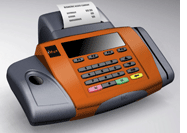21 July, 2006
category: Biometrics, Education, Library
 By Andy Williams, Contributing Editor
By Andy Williams, Contributing Editor
More student choices, more options, and peace of mind for their parents are some of the ideas that went into the development of iMye, Sodexho’s new method of paying for food on or off campus. Oh yes, there’s also the “coolness” factor.
“You don’t need a card or cash, just your finger,” said Ric Rocca, senior vice president of strategy for Sodexho Education Services, of the company’s finger scan technology.
Even the name, “iMye” tracks the idea behind the program: In explaining the genesis of its name, the company explains “I Am Me…My Choices are Mine.”
Said Mr. Rocca: “The name was developed internally and reflects the Millennium Student. They’re individuals. It’s a combination of ‘me’ and ‘my,’ a reflection fo how they view music. They don’t buy albums anymore, just individual music and they want more variety and flexibility in terms of where they’re eating.”
The program – in a pilot stage right now – is at two colleges: Gonzaga University, Spokane, Wash., and the University of North Texas, Denton, Tex. It allows students and faculty to pay for their meals on campus and at select restaurants off-campus with a simple scan of their finger. Both Gonzaga and UNT were chosen for the pilot “because we have had great support from our clients there and from the Sodexho operational team,” said Mr. Rocca. Sodexho handles food service for an estimated 900 campuses across North America.
Dale Goodwin, PR director at Gonzaga, reported that early indications suggest that the system seems to be a success from the student perspective said the “students like it, from what I hear.”
Storing scans not fingerprints to protect privacy
First thing Sodexho wants to make clear is that it’s a “finger scan” not a “fingerprint.” In other words, the actual fingerprint is never stored in the centralized database, only algorithms that allow for simple identification.
 “It’s finger scan technology, not a fingerprint, so a record isn’t kept. It uses 16 points which converts the finger scan into algorithmic numbers, rather than the 64 points used for fingerprint comparisons,” said Charles Wesley, Sodexho general manager in Spokane.
“It’s finger scan technology, not a fingerprint, so a record isn’t kept. It uses 16 points which converts the finger scan into algorithmic numbers, rather than the 64 points used for fingerprint comparisons,” said Charles Wesley, Sodexho general manager in Spokane.
“Essentially,” as the web page points out, the finger scan is simply “a batch of numbers, not your fingerprint” that’s kept on file.
Added Mr. Rocca: “The finger scan takes an image of the student’s finger, then we discard the actual fingerprint.” The later finger scan is compared with the algorithm. The finger scan database is stored centrally on a Sodexho computer and transmitted over the Internet.
How the system works: the student perspective
“Students can sign up online or on campus,” said Mr. Rocca. “They can even mail in an application, but to validate the account, they have to put their finger on a finger reader on campus. Everything else can be done online.” That includes loading, or reloading the student’s account.
It’s a prepaid meal plan type account, a debit system, added Mr. Rocca. “It allows them to go to participating retailers around campus and outlets (off-campus) which have finger scan technology right next to the cash register. Students (or parents) can set up the account for automatic reloads or buy a meal plan. They get dollar for dollar.” In other words, there is no cost to the students.
“This university (Gonzaga) was interested in being part of the pilot program, on the cutting edge,” said Mr. Wesley. “The school is pleased with the ability of the program to offer students a prepaid account to spend on and off campus.”
Mr. Rocca, who heads up iMye, said one of the main concepts that led to its development was that “we’re always looking for ways to better satisfy our clients, our customers. Students want choices and we always try to give them that.”
He said students “like the technology associated with biometrics. They’re comfortable with it, they like the fact they don’t have to carry a card. We’d been looking at the technology for a while. It’s a safe and convenient way to do the same thing that a card does.”
Sodexho has partnered with Biometric Access, a Texas company that produces the finger scan readers. “It’s a good, solid company,” said Mr. Rocca. “They’re growing and they fit the bill with what we needed for this program.”
How the system works: the merchant perspective
Since Sodexho operates a campus’s foodservice program, the readers cost the college nothing; they’re part of the contract. Off-campus, eventually merchants accepting finger scan technology will have to pay a fee. “There are a variety of ways to supply the readers,” said Mr. Rocca. “They can rent it, lease it or buy it outright, but since iMye is still in the test stage, we’re not charging the merchants right now.”
The finger scanner is about eight inches high, four inches wide and takes up about a 6-by-6-inch square space on the cash register table.
One glitch so far, if it can be called that, is transaction speed. Since the finger scan is compared with a database and is transmitted via the Internet, merchants with dial-up connections could experience longer transaction times. Normally, approval is almost instantaneous.
Merchants and the university also have to make sure their cashiers are properly trained. “Once the right amount of training is in place, you save time at the register,” said Mr. Rocca.
“You have to make sure cashiers know how to complete the transaction with somebody’s finger,” added Mr. Wesley. “With a trained cashier and a customer used to finger scanning, it can be faster than cash or credit card. While the cashier is ringing up the order, the customer has the capability to start the finger scan process.”
Moving from pilots to full-blown programs
The pilots at the two schools were initiated mid-term, in the middle of the normal school year. Just 350 students at Gonzaga (slightly more than five percent of its 6,000 students) signed up and about twice that number participated at UNT, said Mr. Wesley. The smaller numbers, however, gave Sodexho time to explore the feasibility of the program.
“We’re expecting a much higher penetration this fall,” said Mr. Rocca.
The program is also going to expand into other colleges in the Spokane area and possibly at UNT as well. “We’re not going to blow it out just yet. We’re trying to make sure it’s the right thing to do, we’re moving cautiously,” said Mr. Rocca. “We want to grow these test accounts first.”
He said some 20 merchants have signed up in Spokane and “a little less” at UNT. Merchant participation, too, is expected to increase this fall.
“The merchants that we are signing up now are predominately either restaurants or grocery stores,” he said. But that’s likely to change as other types of merchants become interested in the program. That could also lead to different types of purses in the student accounts.
“In the near future the money in the students’ accounts will be segmented into buckets of money … some that can be used only for food, some that can be used for anything, such as bookstores and other non food merchants,” said Mr. Rocca.
“Students seem happy with the program and our clients seem happy,” said Mr. Rocca. “The system works well, kids like the technology, the coolness of it. We’re really excited about it. Bottom line is it gives kids more options, more choices in where and how they eat. And it gives parents the peace of mind that their students are using the money they send them for food.”
Or, as Mr. Wesley pointed out, iMye “is about touching the future.”
Additional resources:
To learn more about iMye on the web, click here.




